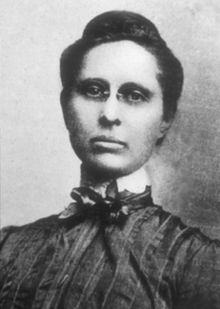Henrietta Cuttino Dozier
Henrietta Cuttino Dozier (born April 22, 1872 in Fernandina Beach , Florida , † April 17, 1947 in Jacksonville , Florida) was an American architect . She was the first female architect in Georgia to receive formal architectural training and graduate from a nationally recognized architecture school. Their designs included churches, schools, banks, government buildings, houses and apartments.
life and work
Cuttino Dozier was the third child of Cornelia Ann Scriven and Henry Cuttino Dozier, who died before they were born. Her mother moved with her and her sister to Atlanta , where she graduated from Girls High School in 1891 and then studied in an architecture firm. She studied at the Pratt Institute in Brooklyn , New York City, and earned a Bachelor of Science degree in architecture from the Massachusetts Institute of Technology in 1899 , where she was one of only three women in the class of 176 students and the only female member to graduate . Throughout her career, she used various neutral or masculine sounding variants of her name including HC Dozier and Harry Dozier .
Work as an architect
From 1901 she worked in Atlanta with the architect Walter T. Downing and received orders for the episcopal diocese that were approved by Bishop Cleland Kinlock Nelson , including in 1903 the bishop's chapel for the All Saints Episcopal Church.
In 1905 she was the third woman and first woman from the south to become a member of the American Institute of Architects (AIA). 1906 they founded and five prominent architects from Atlanta, Alexander Campbell Bruce , Walter T. Downing , Thomas Henry Morgan , GL Norrman and Harry Leslie Walker , the Atlanta Chapter of the AIA, which they at the 8th International Congress of Architects in 1908 Vienna , Austria , represented . In addition to serving on the AIA board from 1906 to 1916, she also helped establish the short-lived Architectural Arts League in Atlanta in 1910. She also helped create a scholarship fund for the new School of Architecture at the Georgia Institute of Technology in Atlanta.
In 1914 she moved to Jacksonville and worked for the city's engineering department during World War I. In 1918 she opened an architecture office. At the beginning of the Great Depression, she lost the house she had designed due to dwindling income, but her office was active again until 1936. Well-known buildings that were designed by her in Jacksonville include the Old Federal Reserve Bank Building (1923-1924 in collaboration with the Atlanta architect A. Ten Eyck Brown) and the Lampru Court Apartments (1924).
She criticized the modernist architectural style as a mere fad and instead believed in the classic traditions of good style and high quality materials. In 1939, she participated in an interview that Rose Shephered conducted for the Federal Writers' Project, a federal government project to fund written work and assist writers during the Great Depression. Here she discussed "the dammed house" and her conviction that this energy-efficient, vermin-resistant, comparatively inexpensive form of living is suitable for the southern climate and would eventually become established.
Building (selection)
- 1898: GW Gignilliat House, Seneca (South Carolina)
- 1902: John C. Cooper House, Jacksonville
- 1903: St. Philips Episcopal Church, 801 N. Pearl Street, Jacksonville
- 1903: All Saints Episcopal Chapel, Atlanta
- 1909: John Blackmar House, Changes, Columbus, Georgia
- 1923–1924: Branch of the Federal Reserve Bank of Atlanta , Jacksonville, with the architect A. Ten Eyck Brown of Atlanta
- 1924: Lampru Court Apartments
- 1925: Welshan Palmer House, Riverside, Jacksonville.
See also
literature
- Sarah Allaback: The first American women architects , University of Illinois Press, 2008, ISBN 978-0252033216 .
- Dictionary of Georgia Biography , eds. Kenneth Coleman and Charles Stephen Gurr, University of Georgia Press, 1983.
- Susan Hunter Smith: Women Architects in Atlanta, 1895–1979 , Atlanta Historical Journal 23, Winter 1979–80.
Web links
- Sharp, Leslie N .: Henrietta Dozier (1872-1947). New Georgia Encyclopedia. November 20, 2013. Web. August 03, 2020.
- Spotlight Henrietta Dozier
| personal data | |
|---|---|
| SURNAME | Cuttino Dozier, Henrietta |
| ALTERNATIVE NAMES | Dozier, Henrietta |
| BRIEF DESCRIPTION | American architect |
| DATE OF BIRTH | April 22, 1872 |
| PLACE OF BIRTH | Fernandina Beach , Florida |
| DATE OF DEATH | April 17, 1947 |
| Place of death | Jacksonville , Florida |

